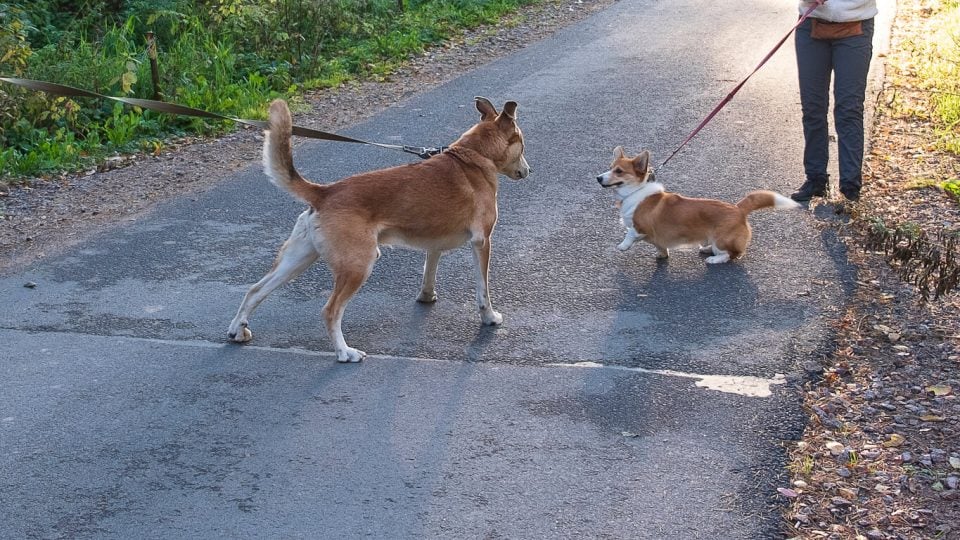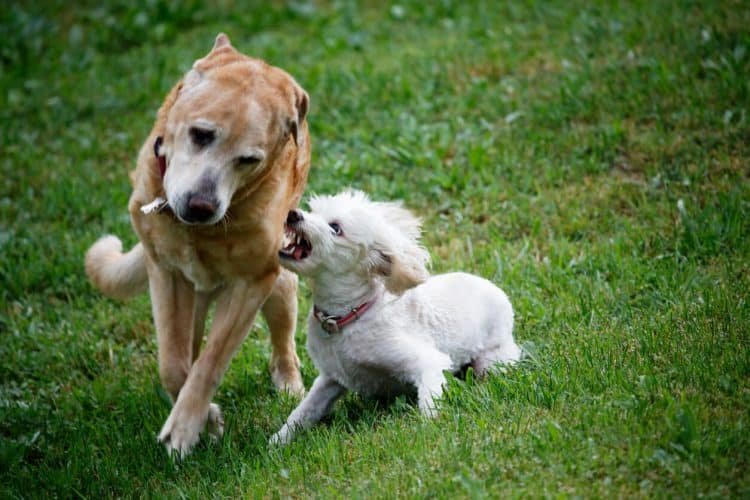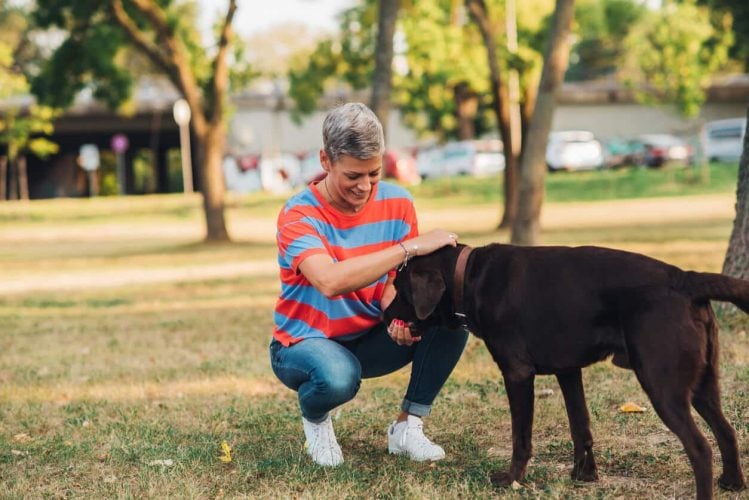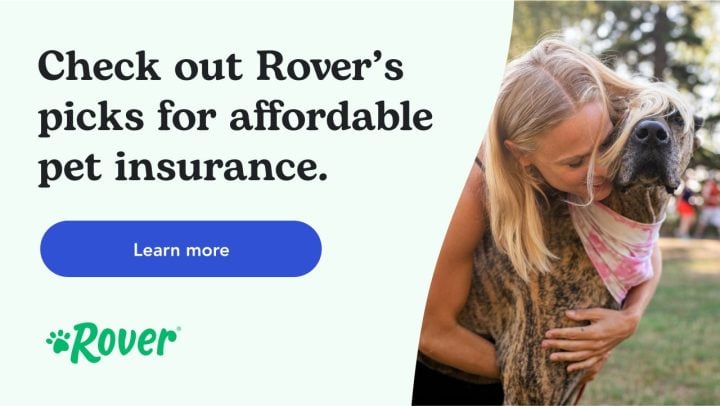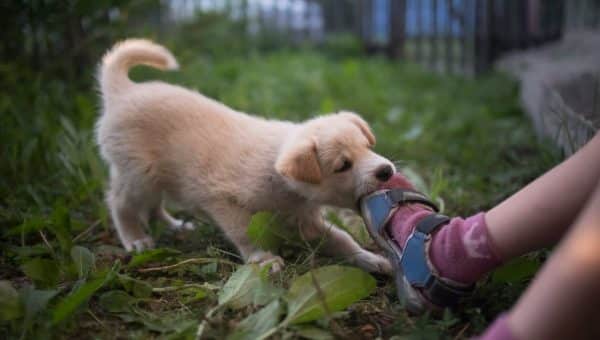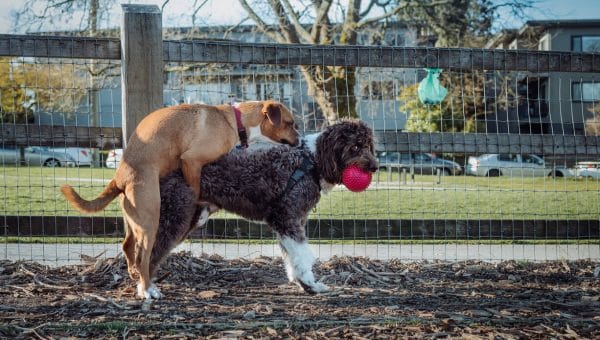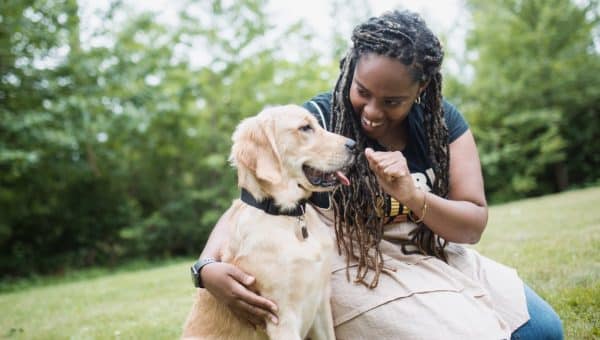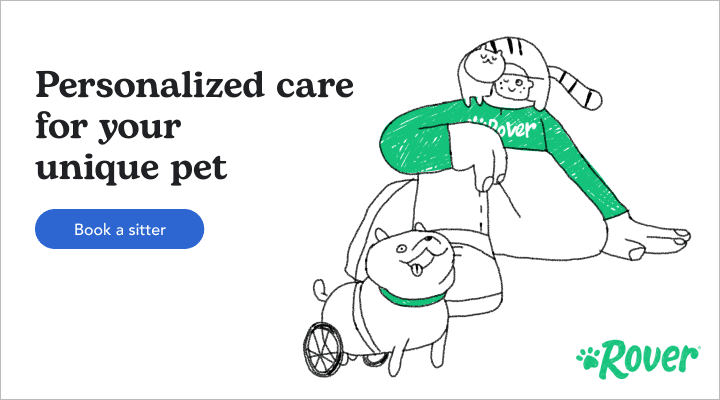- This post contains affiliate links. Read more here.
- Not a substitute for professional veterinary help.
A well-mannered pup doesn’t get into dog fights, right? Not always! That’s why it’s essential to know how to stop a dog fight safely.
Feelings of fear and anxiety may cause aggression in dogs, says Dr. Joana Babo, DVM, Clinical Development Lead at Maven.Pet. Dogs may then get into fights to defend themselves, guard their resources, or protect their humans.
To put it simply, dogs aren’t “bad” for getting into fights, and even well-trained dogs can find themselves in a conflict. And of course, dog fights are serious no matter what causes them. They can lead to injuries, even death.
Read on to learn how to stop a dog fight safely and—even more importantly—protect your pup by keeping the fight from happening in the first place.
Is It Really A Fight, Or Just Rough Play?
Dogs love to play, and sometimes their play can look pretty rough. For example, they may gently bite each other’s necks. These pointers can help you tell the difference between play fighting and a real fight.
| Rough Play | Aggression |
| Wide open “smile” | Bared teeth, snarling, raised or trembling lip |
| Loose posture | Stiff, scared posture |
| Tail relaxed, wagging tail, or otherwise moving in a full range of motion | Tail tucked between legs |
| Ears in a relaxed, normal position or perked up | Ears pinned to head |
| Playful barks, growls, and yelps | Low-pitched growls, snarls, yaps, yelps or whines |
| Eyes move freely (not focused on one subject for more than a few seconds) | Hard stare |
| Play bowing | Yawning or licking the lips |
According to the San Francisco SPCA, your dog might be a bully if they continuously jump on top of, pin down, or chase and nip at other dogs.
On the other hand, your dog may be trying to defuse a conflict or other situation if they:
- Lick the face or mouth of the other dog
- Paw gently at the face of the other dog
- Have their head down, low, or turned away from the other dog
- Hold their tail low, tucked, or wag it weakly
- Hold their ears back and low
- Roll on their back with belly exposed
- Urinate while crouching or on their back
How To Keep Stressed Dogs From Fighting
You’re one step closer to preventing dog fights if you recognize your dog tends to get stressed easily. For example, maybe they startle easily, are very possessive of food or toys, and don’t play nice with others.
The next step involves getting help from a dog behavior professional, though Babo says finding a good trainer can be challenging.
Don’t work with anyone who uses punishment as a tool for behavioral changes. Punishment can increase feelings of fear and anxiety while hurting your dog’s confidence. It only puts your dog more on edge.
Stick with positive reinforcement
“The key is to seek and adopt training plans solely based on positive reinforcement,” Babo says.
This training method that rewards dogs for good behavior. It can also boost their confidence and trust in people and the environment and may help desensitize them to negative triggers.
In the meantime, avoid places that could trigger your dog. High-risk environments include dog parks and dog-friendly patios. You’ll likely also want to skip the doggie play dates if your pup is territorial.
Tip: If you have to bring your dog somewhere triggering, a muzzle is your best bet for protecting them and others.
How to calm an aggressive dog
Whether your dog is the aggressor or the victim, physically separate your dog as soon as you notice signs of an unfriendly interaction.
For instance, you can use a treat or toy to distract them.
Then, without putting your body between the two dogs, create space between them and add a physical barrier if possible.
How to Stop A Dog Fight That’s Already Happening
As a dog parent, your first instinct may be to pull your dog to safety. But before you do, remember that physical intervention may put you at risk of a dog bite.
Instead, try these steps:
- Distract the dogs: This is the safest way to break up a dog fight, but it isn’t always effective. As a start, you can try clapping your hands, banging loud metal objects together, beeping your car horn, or spraying the dogs with a hose. The goal is to get the dogs’ attention long enough to separate them.
- Separate the dogs: Rather than your own body, use another object to create a barrier between the dogs. Grab a cookie sheet from the kitchen, a piece of cardboard, or anything large that can help keep your hands further away from the dogs’ mouths and reduce your risk of a bite.
- Pull your dog away: As a last resort, grab your dog’s thighs, lift them into a wheelbarrow position, and pull them backward. Avoid reaching for their collar, since you may end up getting bitten.
Unlocking a dog bite
Never put your hands near a dog’s mouth to unlock a bite. Instead, you can use a break stick to break the bite. If your dog has aggressive tendencies, it may be worth carrying one. If you don’t have a break stick, use the wheelbarrow method described above to loosen their grip and separate the dogs.
Restraining a reactive dog
Once the two dogs are separated, it’s important to keep them isolated. Get them away from the stimuli that triggered the fight, Babo says. If a fight broke out between two dogs at home, they might mean removing a toy that caused resource guarding and keeping the dogs in separate, secure rooms.
It’s important not to punish your dog for the behavior, she adds. “Dogs rely heavily on predictability, so creating a sense of safety and routine will significantly decrease the chances of future incidents.”
How To Stop A Dog Fight At Home
Whether your dogs have never gotten along or something has recently shifted in their dynamic, a qualified dog trainer or behaviorist can help you develop a plan to stop dog fights in your home.
Your plan may include:
- Taking steps to reduce their anxiety
- Reintroducing your dogs
- Using positive reinforcement to shift problem behaviors
- Creating positive reactions to stimuli that might otherwise cause aggression, like meals
Never let two dogs “work it out” with a fight, cautions Ali Smith, an award-winning trainer certified through the United Kingdom-based Institute of Modern Dog Trainers and founder of Rebarkable.
Instead, you need to protect the victim. This means keeping your dogs separated and never letting them interact unsupervised. If you know which dog is the aggressor, put a bell on their collar. This will help make sure the victim always knows where the other dog is.
If you don’t have the resources to train your dogs or hire a professional behaviorist and the aggression between your dogs has made life unsafe for you, your family, or the dogs, rehoming is the responsible choice.
Should you get involved if you don’t know the dogs?
If the fight isn’t too serious, you can try using the steps above to distract the dogs. Then, only if it’s safe to do so, use an object to create a physical barrier between the dogs.
Never approach an aggressive dog you don’t know.
If the dogs are large or the fight is serious, call for help. You can call the authorities, the local animal shelter, or a dog trainer. Do not try to break up the fight yourself, as you could be injured.
Checking Your Dog For Injuries
Disputes or rough play can lead to a nick on the ear, top of the head, or shoulders. Dog fights can lead to serious injuries, with dogs often targeting their opponent’s neck.
Once it’s safe to do so, check your dog for any obvious signs of injury, such as missing fur and open wounds. Even if you don’t find any injuries, take your dog to the veterinarian right away.
“Even small puncture wounds should be thoroughly examined, as internal tissue damage may be more severe than what is visible on the surface,” Babo says, adding that the number of bacteria in a dog’s mouth could easily lead to an infection.
Always ask the other pet owner for proof of a rabies vaccination.
How To Help A Dog Who Keeps Fighting
If your dog seems to always get picked on or tends to show aggression toward other dogs, it’s important to seek professional help. A canine behaviorist can help you identify the root cause of your dog’s behavior and develop a long-term plan to address it. This may include behavior modification training, reactive leash training, and education on learning to recognize and respond to dog body language.
Smith adds that it’s important to take your dog to the vet if you notice any changes in their behavior, including increased aggression. Underlying medical conditions could be contributing to this behavior, she says.
Dog fights are scary, but there’s a lot you can do to avoid them. Plenty of professionals can provide guidance on training, counter-conditioning, and desensitization to help improve your pup’s interactions with other dogs.
